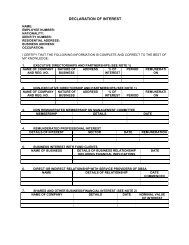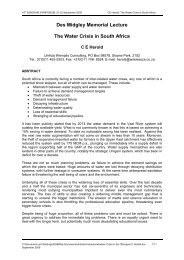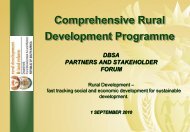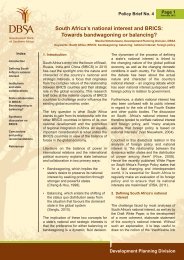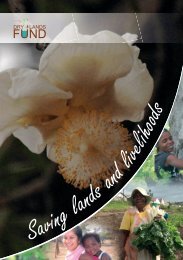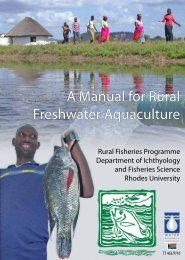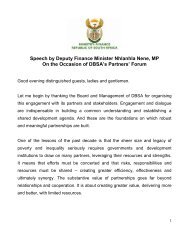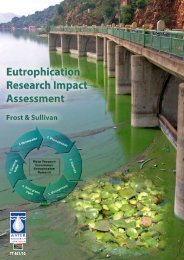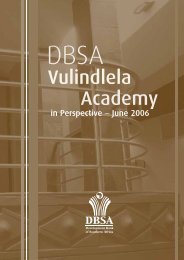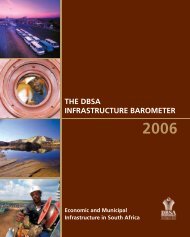ANNUAL REPORTS
ANNUAL REPORTS
ANNUAL REPORTS
You also want an ePaper? Increase the reach of your titles
YUMPU automatically turns print PDFs into web optimized ePapers that Google loves.
LETTERS TO THE STAKEHOLDERS | GOVERNOR’S FOREWORD<br />
Development impact overview<br />
The section highlights key development impact initiatives<br />
during the year under review, starting with an overview of the<br />
macroeconomic impact of the Bank’s operations. This is followed<br />
by a review of initiatives carried out by the Bank’s capacity<br />
building arm, the Development Fund, which comprises three<br />
divisions: Capacity Development and Deployment; Community<br />
Development Facilitation; and Rural Development.<br />
Macroeconomic impact<br />
The DBSA uses a partial general macroeconomic equilibrium<br />
model based on a social accounting matrix (SAM) to calculate<br />
the socio-economic impact of its projects. The model<br />
specifically incorporates the sectoral investment focus of the<br />
Bank. The model, which has 2006 as a base year, has been<br />
adjusted to 2010 prices, and the discussion below is in real<br />
(inflation-adjusted) terms.<br />
In 2010/11, the DBSA approved projects to the value of<br />
R34,2 billion. The value of the Bank’s signed agreements<br />
with clients was R13,9 billion and the disbursements were<br />
R8,3 billion. The bulk of the disbursements (70%) in South Africa<br />
went to energy (28,7%), transportation (19,3%), communication<br />
(14,1%) and entrepreneurial and manufacturing (7,9%).<br />
The SAM models were used to calculate the impacts of the<br />
DBSA’s funding, and these were compared to the previous<br />
year’s results. The findings are shown in the graphs below.<br />
Note that the approved funding portfolio is generally only<br />
disbursed in future years. This portfolio will therefore have only<br />
a potential impact, which will come into effect once the funds<br />
are actually disbursed. The same holds for signed agreements.<br />
Hence, only the disbursed funding portfolio can be said to<br />
have an actual development impact. The graphs below show<br />
the impact of all three of the portfolios. These figures are<br />
estimates of the average annual impact on the economy over<br />
the medium term and not specifically for the year ahead.<br />
It is estimated that the total funding approved by the Bank<br />
has a potential impact of R28,3 billion on the GDP, of which<br />
R20 billion will be in South Africa. This constitutes approximately<br />
0,75% of South Africa’s GDP in 2010/11 (2009/10: 0,49%).<br />
The actual impact of the Bank’s disbursements on the GDP<br />
of the African region is estimated at R7,8 billion, of which<br />
R4,5 billion is in South Africa.<br />
The total funding approved by the DBSA in 2010/11 has<br />
an estimated potential impact on employment creation of<br />
over 147 100 employment opportunities in the African region. 1<br />
Of these, 95 300 employment opportunities could be created<br />
in South Africa. The Bank’s own disbursements will create<br />
an estimated 42 600 employment opportunities, of which<br />
22 200 (52%) will be in South Africa (down from the 2009/10<br />
figure of 31 600).<br />
To support the economic activity initiated by these<br />
disbursements, a capital amount of R22,5 billion will be<br />
employed, directly and indirectly, in the African region.<br />
Over R14,7 billion of this will be in South Africa, made up of<br />
R5,4 billion in DBSA disbursements and R9,3 billion in capital<br />
invested by other industries to supply the additional materials<br />
and goods required. This amounts to 2,8% of South Africa’s<br />
total gross fixed capital formation in 2010/11.<br />
Every investment results in additional income to households<br />
through economic linkages. The total funding approved by the<br />
DBSA has the potential to create additional household income<br />
of R13,2 billion in South Africa. Of this amount, R2,2 billion will<br />
be to the benefit of low-income households earning less than<br />
R33 120 a year. The Bank’s disbursements will create additional<br />
total household income of R3 billion in South Africa, of which<br />
R0,5 billion will accrue to low-income households.<br />
The investments also contribute to government revenue for<br />
all three spheres of government (national, provincial and<br />
local) through the taxes paid on additional economic activity.<br />
This additional tax revenue as a result of the Bank’s<br />
disbursements in South Africa is estimated at R1,4 billion.<br />
Estimated impact on GDP in South Africa,<br />
2009/10 and 2010/11<br />
R billion<br />
25<br />
20<br />
15<br />
10<br />
5<br />
0<br />
Estimated impact on employment in South Africa,<br />
2009/10 and 2010/11<br />
Thousand<br />
100<br />
80<br />
60<br />
40<br />
20<br />
0<br />
Approvals: DBSA Signed agreements Disbursements<br />
2009/10 2010/11<br />
Approvals: DBSA Signed agreements Disbursements<br />
2009/10 2010/11<br />
1. Labour and capital impacts on countries outside South Africa were estimated through SAMs of the relevant countries, but based on South African direct labour and<br />
capital multipliers.<br />
26 DBSA DBSA | <strong>ANNUAL</strong> | <strong>ANNUAL</strong> REPORT REPORT 2010/11 2010/11



